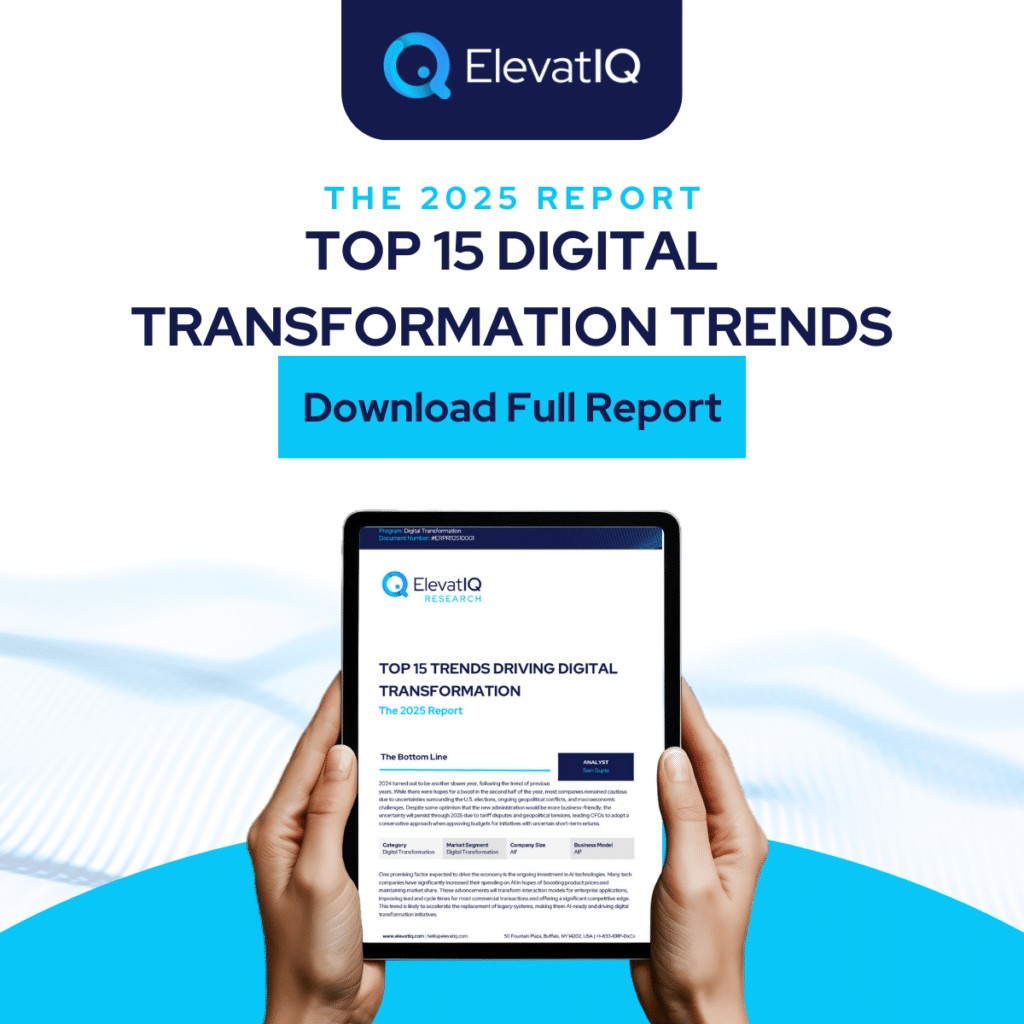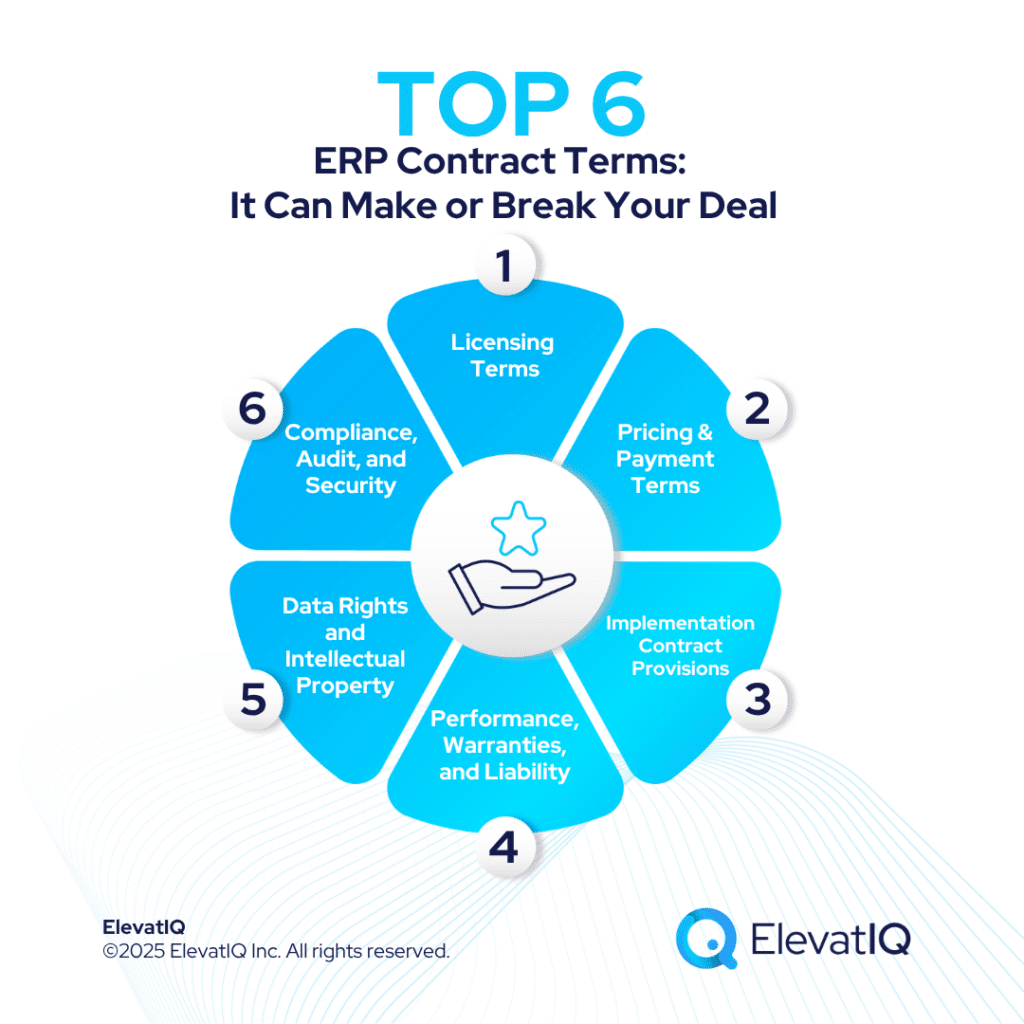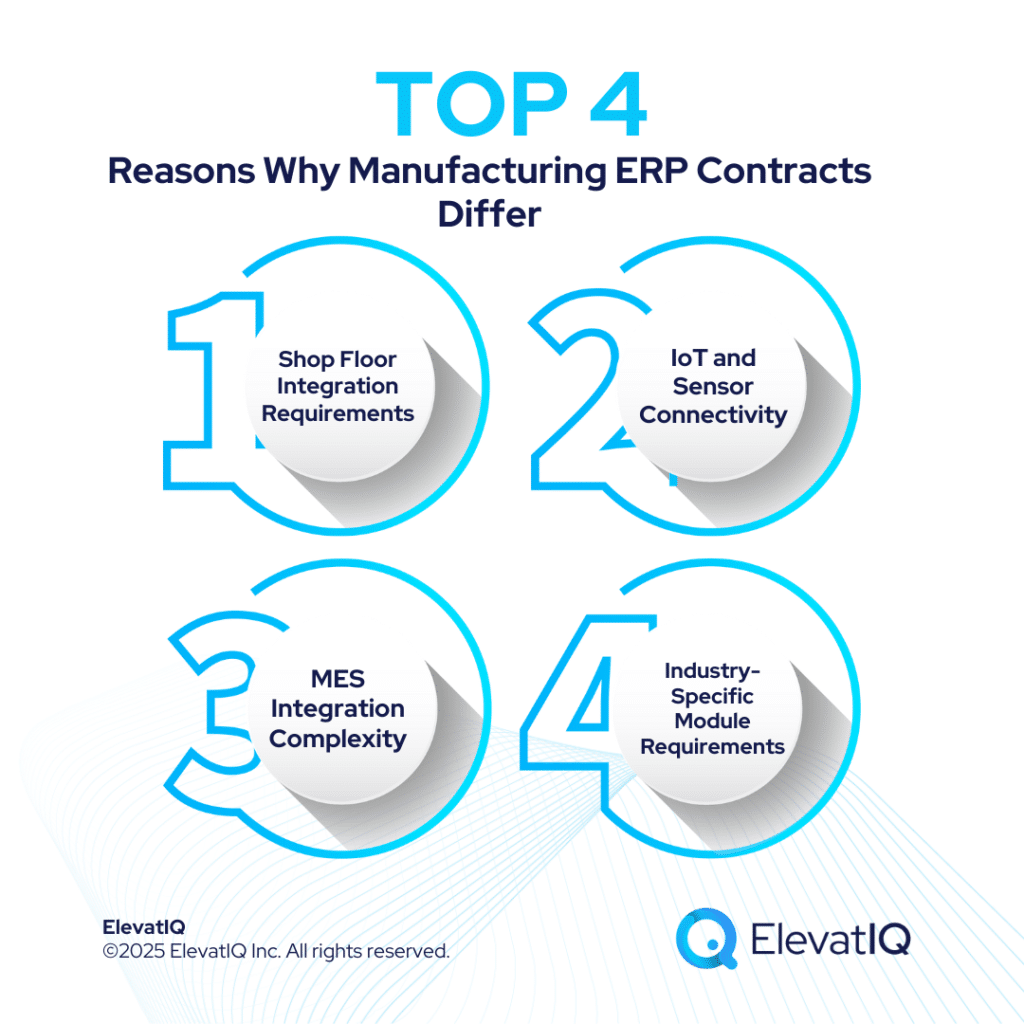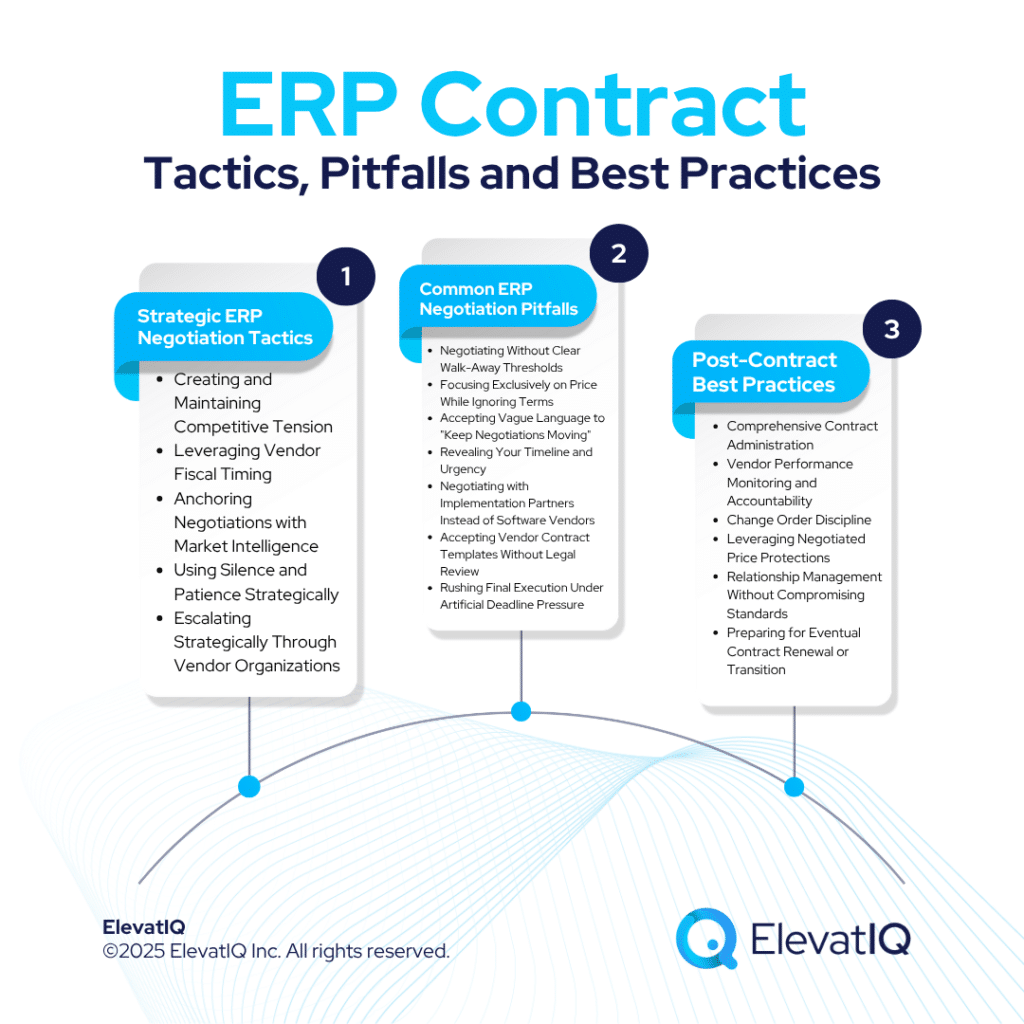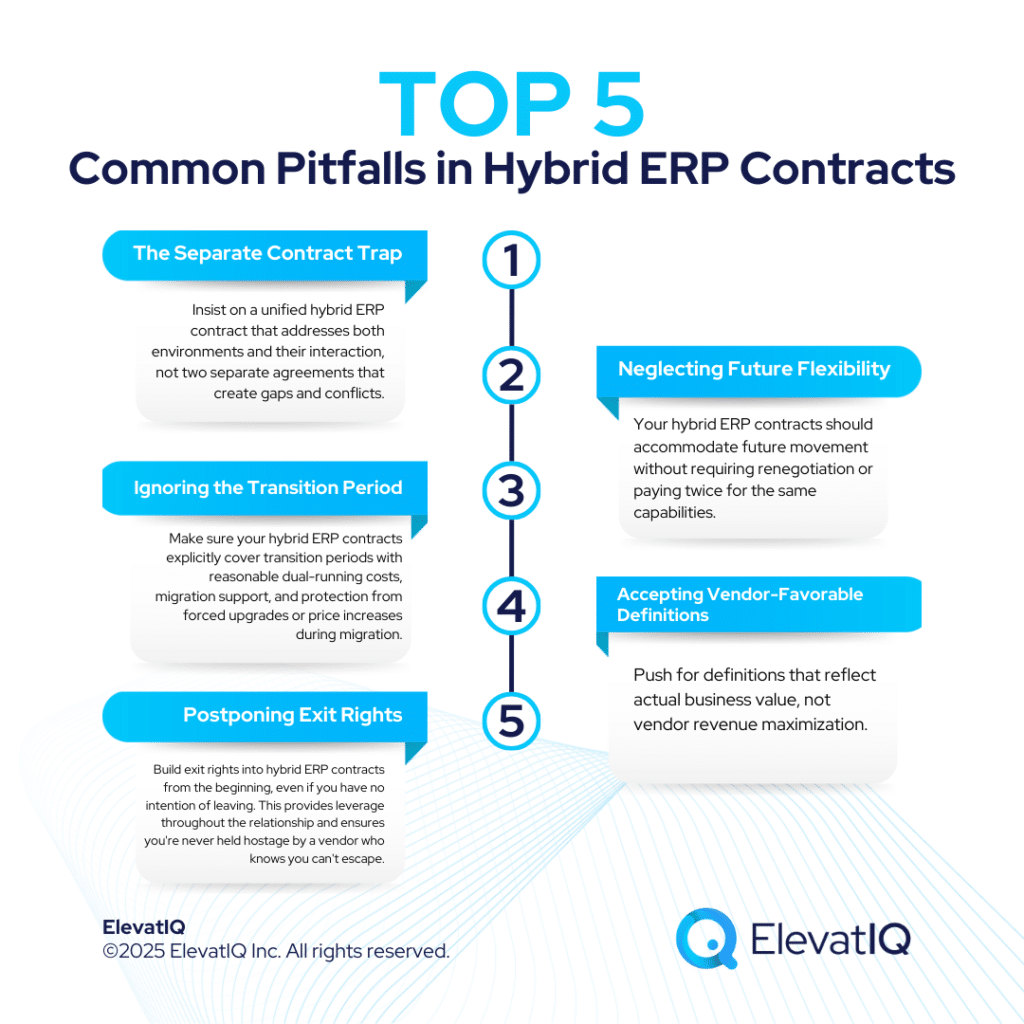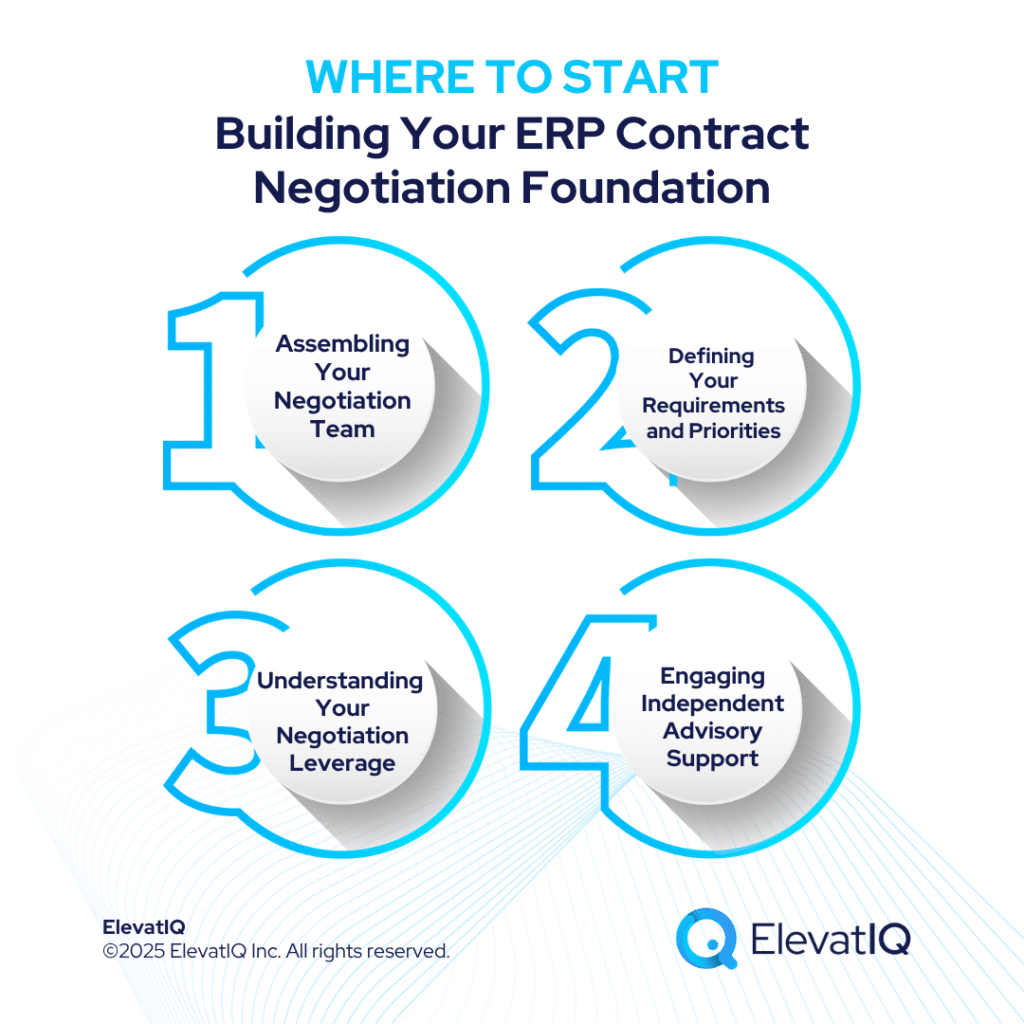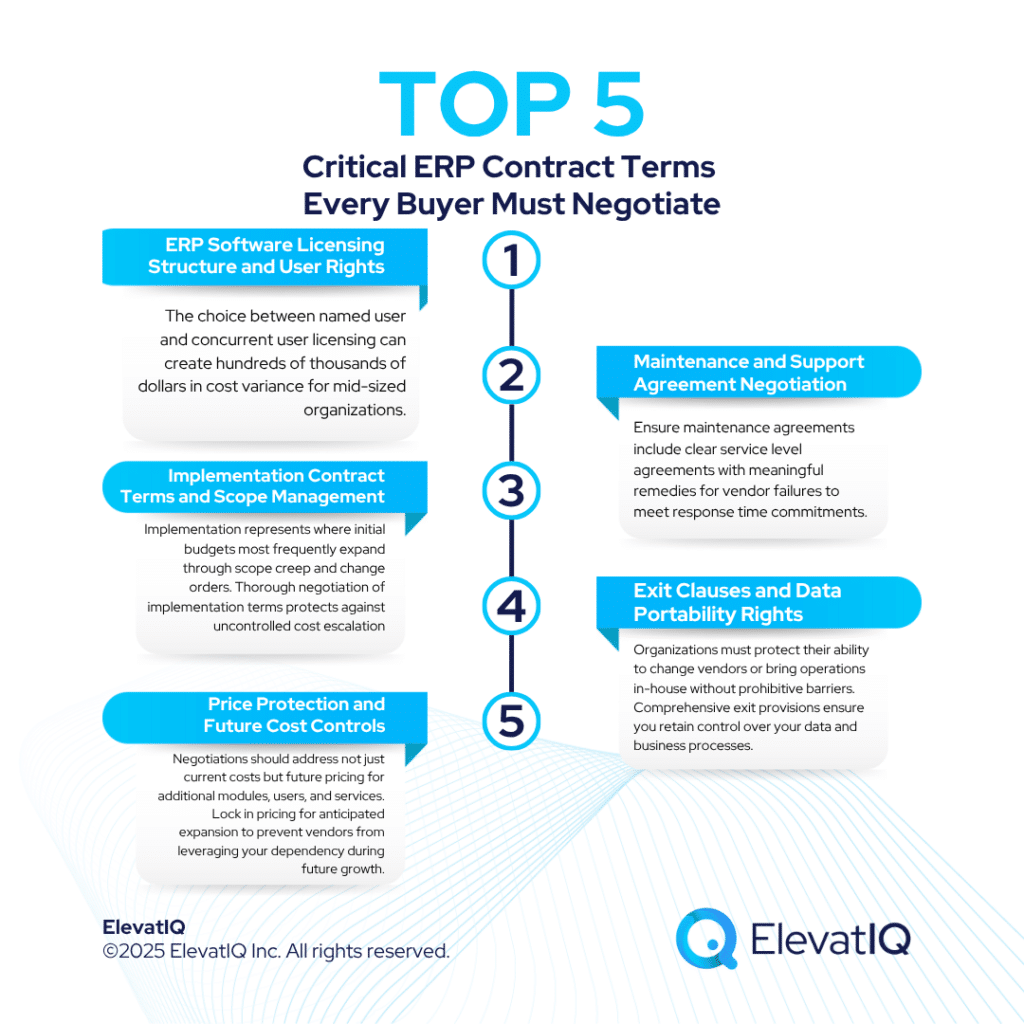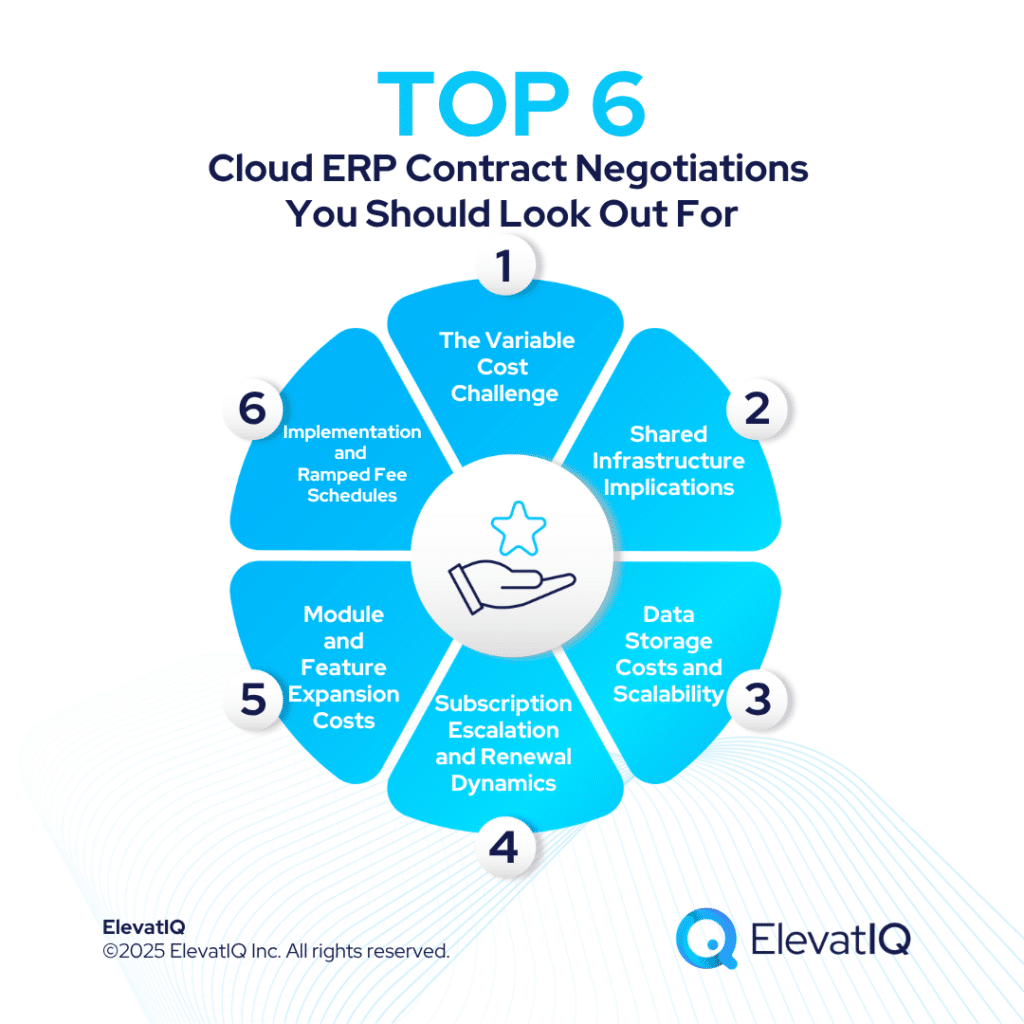Last Updated on October 22, 2025 by Shrestha Dash
The difference between a successful ERP investment and a problematic deployment that drains resources often lies not in the software selection itself, but in the contract terms governing the relationship. While organizations invest months evaluating functionality, features, and vendor capabilities, many rush through contract negotiations without recognizing which specific clauses will determine long-term success or create years of operational and financial challenges.
ERP contracts contain dozens of provisions addressing licensing, pricing, implementation, support, liability, and termination. Understanding which terms critically impact your organization and how to negotiate favorable language in each area separates buyers who protect their interests from those who unknowingly accept one-sided agreements that favor vendors at their expense. This comprehensive analysis examines the ERP contract terms that truly make or break deals, explaining what each provision means, why it matters, and how to negotiate language that serves your long-term interests.
Licensing Terms: The Foundation of Your ERP Investment
Licensing provisions establish the fundamental economic model for your ERP relationship, determining not just initial costs but ongoing expenses and operational flexibility for the duration of your system usage.
User Definition and Licensing Models
How contracts define “users” and structure licensing directly impacts both immediate costs and future flexibility. The distinction between named user and concurrent user licensing creates vastly different economic outcomes.
- Named User Licensing assigns licenses to specific individuals who may access the system, regardless of actual usage patterns. This model generates higher revenue for vendors from organizations with many occasional users who rarely access the ERP simultaneously.
- Concurrent User Licensing allows a defined number of simultaneous users from a larger population. Organizations with many users who access the system intermittently typically achieve better economics with concurrent licensing.
Beyond the basic model, user definitions require precise negotiation. Vague definitions like “any individual with system access” enable vendors to claim license violations during audits for users you never intended to count. Negotiate explicit definitions that clearly specify which roles require licensing and which do not.
Critical licensing terms to negotiate include:
- Precise user definitions that limit who requires licenses
- Transfer rights allowing license reassignment between employees without fees
- Internal use provisions clarifying that testing, training, and development environments don’t require separate production licenses
- Contractor and temporary worker treatment establishing whether short-term staff require full licenses
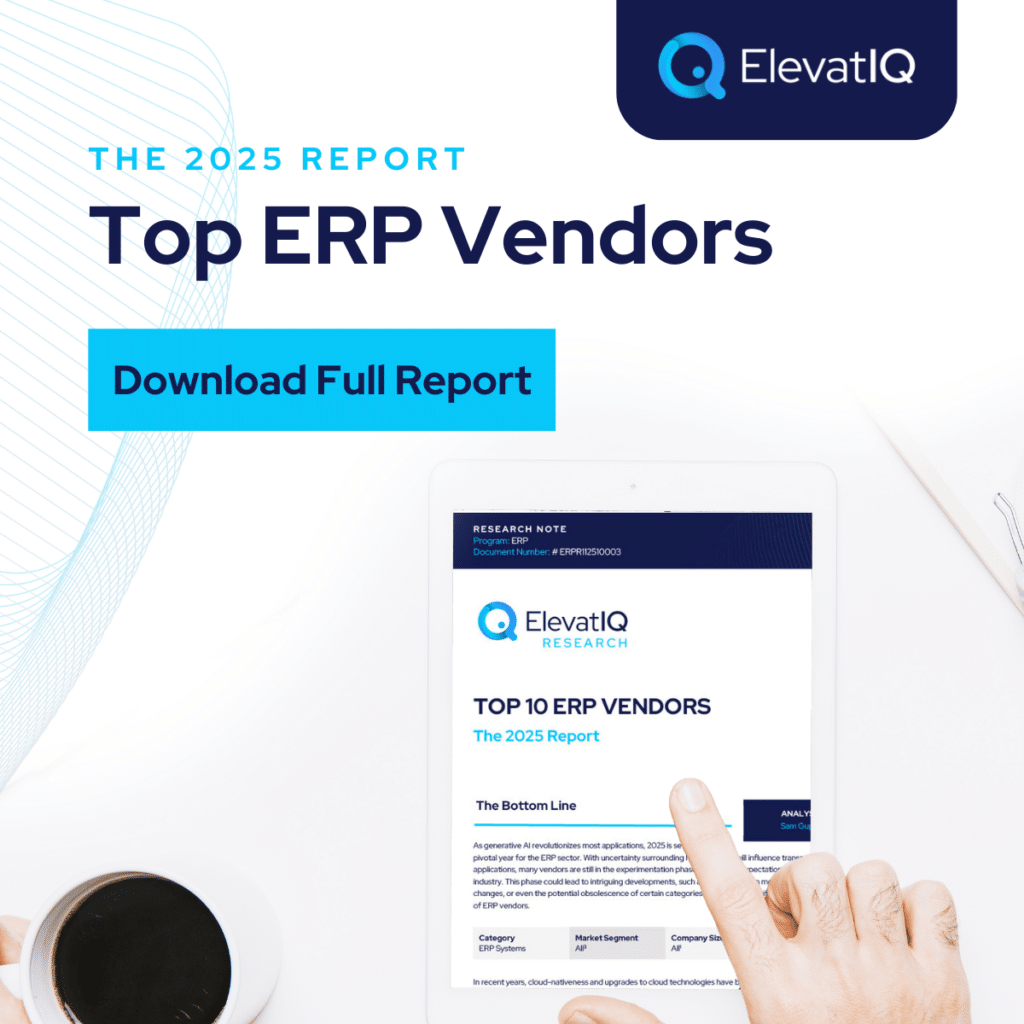
Volume Tiers and Growth Provisions
Most ERP vendors structure pricing in volume tiers, with per-user costs decreasing as license counts increase. However, contracts often include provisions that penalize growth by resetting pricing to higher tiers or requiring minimum purchase quantities that exceed actual needs.
Negotiate pricing that:
- Locks in volume discounts for your current size
- Establishes pre-agreed pricing for anticipated growth
- Eliminates minimum purchase requirements when adding users incrementally
- Provides step-down pricing as you cross volume thresholds naturally
Entity and Geographic Scope
Organizations with multiple legal entities or international operations must ensure licensing covers their entire corporate structure without additional fees. Standard contracts often limit licenses to single entities or geographies, creating unexpected costs when you deploy across subsidiaries or countries.
Negotiate enterprise-wide licensing that:
- Defines “affiliate” broadly to include acquired companies
- Covers all current and future subsidiaries
- Extends to all geographies without additional fees
- Allows license pooling across entities
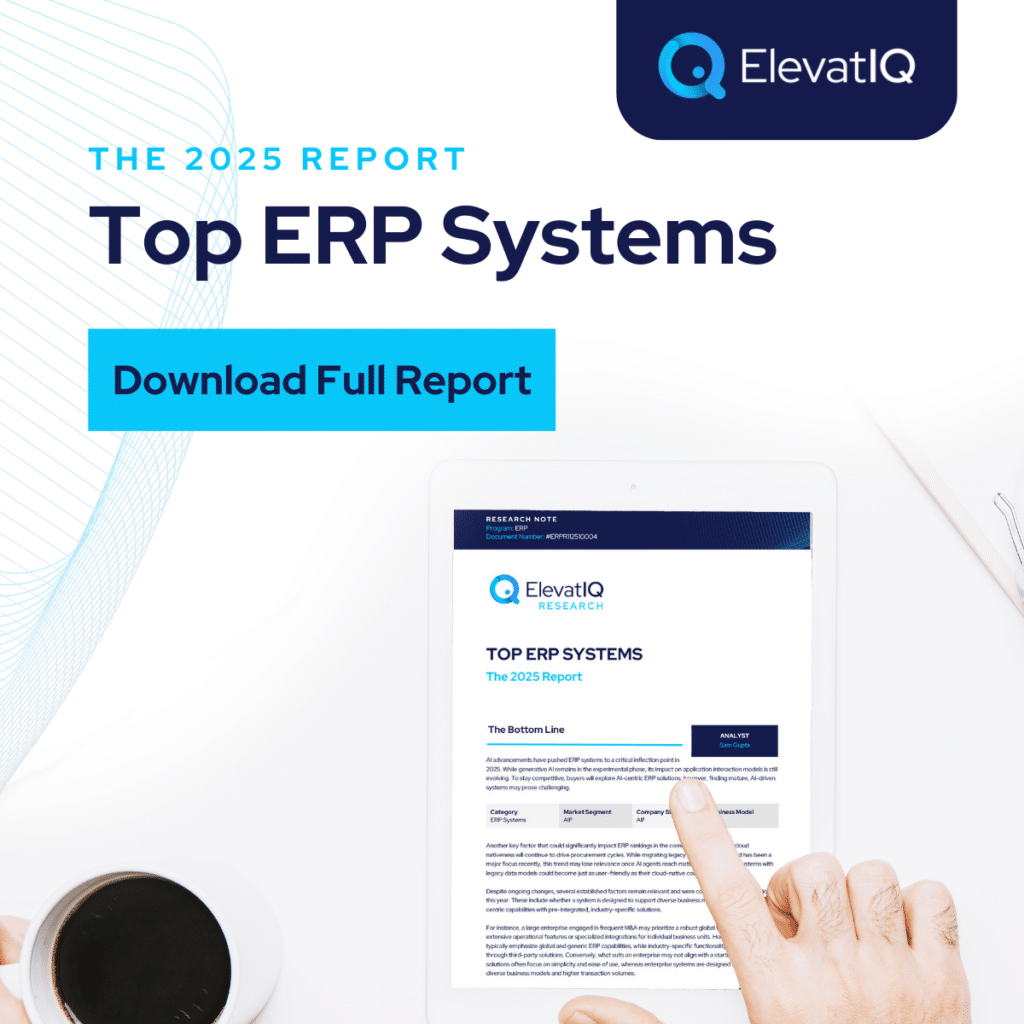
Pricing and Payment Terms: Controlling Financial Obligations
Beyond licensing structure, specific pricing and payment provisions determine cash flow impacts, cost predictability, and total ownership economics.
Maintenance and Support Fees
Annual maintenance represents vendors’ most profitable revenue stream, typically starting at 18-22% of license value but increasing annually through escalation clauses that compound over time. A $1 million annual maintenance fee increasing 5% annually grows to $1.63 million within ten years—a 63% increase that many buyers fail to anticipate.
Negotiate maintenance terms that:
- Establish service credits when vendors fail to meet support commitments
- Cap annual increases at specific percentages (ideally 2-3%, tied to CPI)
- Lock in multi-year pricing to prevent arbitrary escalation
- Specify included services clearly, preventing vendors from charging separately for items maintenance should cover
Price Protection for Future Purchases
Initial contracts rarely include all modules, users, or capabilities you’ll eventually need. Without price protection provisions, vendors can charge premium pricing for additions once they recognize you’re locked into their platform.
Secure commitments for:
- Most-favored-customer pricing on future module purchases
- Pre-agreed discount levels for additional users
- Defined pricing for specific modules you anticipate adding
- Protection against vendors discontinuing favorable pricing programs after you commit
Payment Terms and Schedules
Payment timing significantly impacts cash flow and provides leverage to ensure vendor performance. Standard vendor terms often demand large upfront payments before delivery, reducing your leverage if problems arise.
Negotiate payment structures that:
- Tie payments to milestone completion and acceptance
- Retain meaningful percentages until final acceptance
- Extend payment terms to improve cash flow
- Separate license payments from implementation services to maintain leverage

Implementation Contract Provisions: Defining Scope and Accountability
ERP implementation agreements determine project execution frameworks, risk allocation, and remedies when vendors fail to deliver as promised.
Scope Definition and Deliverables
Vague scope language creates the primary source of implementation disputes and cost overruns. Every ambiguous phrase represents potential future disagreement over whether functionality is in-scope or requires additional payment.
Demand exhaustive scope documentation including:
- Detailed functional specifications describing exactly what the system will do
- Explicit deliverables lists with clear descriptions and formats
- Acceptance criteria defining how you’ll verify deliverable completion
- Assumptions and exclusions clearly stating what’s not included
Avoid phrases like “best practices configuration,” “reasonable efforts,” or “industry-standard functionality” that allow interpretation disputes. Require specific, measurable descriptions of deliverables.
Fixed Price vs. Time and Materials
Implementation pricing models allocate risk differently between buyers and vendors. Fixed-price contracts place delivery risk on vendors but require extremely precise scope definition. Time and materials arrangements provide flexibility but need robust controls to prevent budget overruns.
For fixed-price implementations, negotiate:
- Comprehensive scope documentation that defines all deliverables
- Clear change order procedures with pricing methodologies
- Vendor accountability for efficiency and timeline adherence
- Meaningful penalties for vendor-caused delays
For time and materials engagements, establish:
- Pre-agreed rates for different resource levels
- Not-to-exceed caps that limit total spending
- Required approvals for work beyond defined budgets
- Regular progress reporting and budget consumption tracking
Change Order Procedures
Regardless of implementation pricing models, projects encounter scope changes requiring formal change order processes. Without clear procedures, vendors can inflate change order pricing or claim every deviation from imprecisely defined scope requires additional payment.
Negotiate change management provisions that:
- Define what constitutes a legitimate change vs. clarification of vague scope
- Establish pricing methodologies for different change types
- Require written approvals before change order work begins
- Limit vendor’s ability to claim changes for items reasonably implied by documented scope
Resource Qualifications and Stability
Vendor proposals showcase senior resources during sales cycles, then assign less experienced staff to actual implementations. Without contractual protections, you may find junior consultants handling critical tasks while paying premium rates.
Secure commitments regarding:
- Minimum experience levels for key project roles
- Specific named resources for critical positions
- Vendor approval requirements before substituting resources
- Remedies when vendors assign unqualified staff
Performance, Warranties, and Liability: Ensuring Vendor Accountability
Standard vendor contracts typically include minimal performance commitments and limit vendor liability to amounts paid, leaving buyers bearing most implementation risk.
Performance Warranties and Guarantees
Without specific performance warranties, vendors face limited accountability for delivering functional systems that meet documented requirements. Standard contracts often disclaim warranties entirely or provide only that software will “substantially conform” to documentation.
Negotiate warranties that:
- Guarantee system will perform specific business processes documented in scope
- Define clear performance standards (transaction volume, response times, uptime)
- Extend warranty periods to meaningful durations (12+ months post-go-live)
- Specify remedies when systems fail to meet warranted performance
Service Level Agreements
Support responsiveness directly impacts operational continuity when issues arise. Vague support commitments like “reasonable efforts” or “commercially reasonable response times” provide no meaningful accountability.
Demand specific SLAs addressing:
- Response time commitments by issue severity
- Resolution timeframes for different problem categories
- Support availability (hours, days, contact methods)
- Escalation procedures when initial support fails to resolve issues
- Service credits when vendors breach SLA commitments
Limitation of Liability
Perhaps the most one-sided provisions in standard contracts, liability limitations typically cap vendor financial exposure to amounts paid while providing unlimited liability for buyers. These terms mean vendors face minimal consequences for catastrophic failures that cost buyers millions.
While complete elimination of liability caps remains unrealistic, negotiate:
- Higher liability caps that reflect actual potential damages (2-3x annual contract value)
- Carve-outs from caps for specific breach types (gross negligence, willful misconduct, IP infringement)
- Mutual liability limitations that apply equally to both parties
- Insurance requirements ensuring vendors can actually pay if liability is triggered
This upfront clarity provides the foundation for evaluating vendor proposals and engaging in focused negotiations that address terms most critical to your organization.
Data Rights and Intellectual Property: Protecting Your Assets
ERP systems contain your organization’s most critical operational data. Contract terms governing data ownership and intellectual property rights determine your control over this strategic asset.
Data Ownership and Access
While data ownership seems obvious—it’s your data—standard contracts often include ambiguous language that could enable vendor claims to data rights or restrict your access and usage.
Negotiate explicit provisions stating:
- You own all data entered into or generated by the system
- You can access and extract your data at any time in standard formats
- No vendor rights to use, analyze, or commercialize your data without explicit permission
- Data remains your property regardless of contract termination
Customization and Intellectual Property
Organizations frequently require customizations to address unique requirements. Without clear IP provisions, disputes arise over ownership of custom code, configurations, and integrations.
Establish that:
- You own all custom code developed specifically for your organization
- You receive source code for customizations
- You can modify customizations without vendor involvement
- Vendor cannot charge additional fees for accessing or modifying customizations you own
Data Portability and Exit Rights
Eventually, contracts end—whether through normal expiration, vendor business changes, or your decision to switch platforms. Data portability provisions determine whether you can transition smoothly or face barriers that effectively lock you into vendors despite unsatisfactory service.
Negotiate comprehensive exit provisions including:
- Standard format data exports within defined timeframes
- Complete data extraction at no additional charge
- Reasonable transition assistance periods
- Access to system documentation necessary for migration
Compliance, Audit, and Security: Managing Risk and Governance
Organizations in regulated industries or with specific security requirements need contract terms that address compliance obligations and security standards.
Compliance Warranties
If you operate in regulated environments (healthcare, finance, government), ensure contracts include specific compliance warranties rather than generic “compliance with applicable law” language that provides limited protection.
Require:
- Warranties that system meets specific regulatory requirements (HIPAA, SOX, GDPR)
- Vendor responsibility for maintaining compliance as regulations evolve
- Audit rights to verify compliance capabilities
- Indemnification for compliance failures stemming from system deficiencies
Security Standards and Breach Notification
Data breaches create significant liability. Contract terms should establish clear security standards vendors must maintain and procedures for breach notification and remediation.
Negotiate provisions addressing:
- Specific security standards vendors must meet (SOC 2, ISO 27001)
- Regular security testing and vulnerability assessment requirements
- Immediate breach notification obligations
- Vendor liability for breaches caused by inadequate security
Audit Rights
While vendors typically demand license compliance audit rights, these provisions should be balanced to prevent abuse while ensuring appropriate oversight.
Establish:
- Limitations on audit frequency (annually at most)
- Advance notice requirements (60-90 days)
- Restrictions on auditor selection and costs
- Reciprocal rights to audit vendor’s service delivery compliance
Renewal and Termination: Maintaining Flexibility
Contract duration, renewal terms, and termination provisions determine your long-term flexibility and ability to exit relationships that no longer serve your interests.
Automatic Renewal Provisions
Many contracts include automatic renewal clauses requiring 60-90 days advance notice to prevent renewal. Missing these deadlines locks you into additional contract terms, often with embedded price increases.
Negotiate:
- Explicit renewals requiring affirmative action from both parties
- Longer notification periods (120+ days) to prevent inadvertent renewals
- No price increases upon renewal without separate negotiation
- Mutual renewal rights, allowing either party to decline
Termination Rights and Procedures
Beyond normal contract expiration, organizations need termination rights for various circumstances including vendor performance failures, business changes, or strategic technology shifts.
Secure termination rights for:
- Material vendor breaches with cure periods
- Vendor business changes (acquisition, bankruptcy)
- Your business changes (mergers, divestitures)
- Convenience (with reasonable notice and fees)
Ensure termination procedures clearly define:
- Notice requirements and procedures
- Data transition obligations
- Refund calculations for prepaid amounts
- Ongoing obligations post-termination
Negotiating Contract Terms That Protect Your Interests
ERP contracts contain numerous provisions that seem standard or innocuous but significantly impact long-term outcomes. The terms explored here represent areas where thoughtful negotiation creates substantial value through cost savings, risk mitigation, and operational flexibility.
Organizations that understand which contract terms truly matter and invest effort in negotiating favorable language establish foundations for successful implementations and productive vendor relationships. Conversely, accepting standard vendor terms without thorough negotiation creates financial surprises, operational constraints, and limited recourse when problems arise. The contract terms you negotiate today determine your organization’s ERP experience for years to come. Investing time and expertise to secure favorable terms in each critical area represents one of the highest-return activities in the entire procurement process.
For organizations navigating ERP contract negotiations, independent advisory support provides the specialized knowledge and market intelligence necessary to secure contract terms that protect interests while enabling successful implementations.
